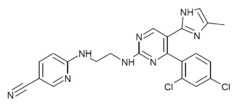Chemistry:CHIR99021
From HandWiki

| |
| Names | |
|---|---|
| IUPAC name
6-((2-((4-(2,4-Dichlorophenyl)-5-(4-methyl-1H-imidazol-2-yl)pyrimidin-2-yl)amino)ethyl)amino)nicotinonitrile
| |
| Identifiers | |
3D model (JSmol)
|
|
PubChem CID
|
|
| UNII | |
| |
| |
| Properties | |
| C22H18Cl2N8 | |
| Molar mass | 465.34 g·mol−1 |
Except where otherwise noted, data are given for materials in their standard state (at 25 °C [77 °F], 100 kPa). | |
| Infobox references | |
Tracking categories (test):
CHIR99021 is a chemical compound which acts as an inhibitor of the enzyme GSK-3.[1] It has proved useful for applications in molecular biology involving the transformation of one cell type to another.[2][3]
A mixture of CHIR99021 and valproic acid (FX-322) is claimed to increase the proliferation of inner ear stem cells, potentially allowing regrowth of the hair cells which are important for hearing, and are lost through chronic exposure to loud noises or as part of the aging process.[4][5][6]
See also
References
- ↑ "Discovery of Potent and Highly Selective Inhibitors of GSK3b". Probe Reports from the NIH Molecular Libraries Program.. Bethesda (MD): National Center for Biotechnology Information (US). 16 April 2012. https://www.ncbi.nlm.nih.gov/books/NBK133436/.
- ↑ "Mechanism of Induction: Induced Pluripotent Stem Cells (iPSCs)". Journal of Stem Cells 10 (1): 43–62. 2015. PMID 26665937.
- ↑ "Chemical compound-based direct reprogramming for future clinical applications". Bioscience Reports 38 (3). June 2018. doi:10.1042/BSR20171650. PMID 29739872.
- ↑ Karp JM, Yin X, Succi MD, Langer RS, "Compositions and methods for epithelial stem cell expansion and culture", US patent 2017226477, published 10 August 2017, assigned to Massachusetts Institute of Technologyand The Brigham and Women's Hospital, Inc.
- ↑ Loose C, McLean W, Harrison M, Jirousek MR, "Solubilized compositions for controlled proliferation of stem cells / generating inner ear hair cells using a GSK3 inhibitor", US patent 11033546, published 15 June 2021, assigned to Frequency Therapeutics Inc.
- ↑ "Clonal Expansion of Lgr5-Positive Cells from Mammalian Cochlea and High-Purity Generation of Sensory Hair Cells" (in en). Cell Reports 18 (8): 1917–1929. February 2017. doi:10.1016/j.celrep.2017.01.066. PMID 28228258.
 |

